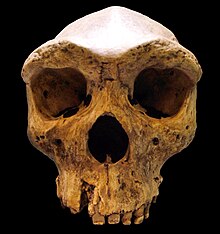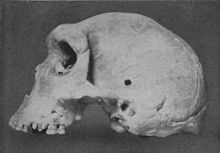Kabwe 1
14°27′36″S 28°25′34″E / 14.460°S 28.426°E
 Replica (Museum Mauer, Germany) | |
| Common name | Kabwe 1 |
|---|---|
| Species | Homo heidelbergensis (Homo rhodesiensis) |
| Age | 324-274 ka |
| Date discovered | 1921 |
| Discovered by | Tom Zwiglaar |
Kabwe 1, also known as the Broken Hill skull and Rhodesian Man, is a Middle Paleolithic fossil assigned by Arthur Smith Woodward in 1921 as the type specimen for Homo rhodesiensis, now mostly considered a synonym of Homo heidelbergensis.[1]
The
The skull is kept in the Natural History Museum, London.[4]
Discovery
Details of the skull's recovery were recorded by Aleš Hrdlička, an anthropologist with the Smithsonian Institution.[3] Swiss miner Tom Swiglaar and an unnamed African miner uncovered the skull on 17 June 1921 while working an ore pocket within the mine.[3] The skull was shown to the mine's managers, who photographed it being held by Swiglaar.[3] It was then examined by a doctor at Broken Hill, who recognized it as a fossil of potential scientific importance.[3] Several months later, the Rhodesia Broken Hill Mine Company shipped it to England, donating it to the British Museum in London.[3] There it was examined by paleontologist Arthur Smith Woodward and identified as belonging to a new species, then identified as Homo rhodesiensis.[3]
Date
The destruction of the paleoanthropological site has made stratigraphic dating impossible. Prior to the 1970s, the skull was believed to be only 30-40,000 years old.
Morphology

The skull has cavities in ten of the upper teeth and is considered one of the oldest known occurrences of cavities. Pitting indicates significant infection before death and implies that the cause of death may have been due to
Classification
Initially, the skull was classified as belonging to a novel species, Homo rhodesiensis, which is now generally classified as a synonym for African subspecies of
Possible repatriation
Since the 1970s, the government of Zambia has petitioned the United Kingdom for custody of the Kabwe skull, citing a number of international laws and treaties on cultural artifacts as well as colonial-era laws made by the United Kingdom.[3] According to the interpretation of the 1912 Bushman Relics Proclamation offered by the Zambian government, it was unlawful in 1921 to remove cultural relics from Northern Rhodesia without a permit from the British South Africa Company, which it maintains was not issued to the Broken Hill mining company prior to its donation of the skull to the British Museum.[3] In May 2018, at a meeting of the UNESCO World Heritage Committee, British delegates agreed to negotiations with Zambia regarding eventual repatriation of the artifact, accompanied by agreements regarding access to the skull and associated scans and digital data by researchers.[3]
See also
- Bodo cranium
References
- ^ Hublin, J.-J. (2013), "The Middle Pleistocene Record. On the Origin of Neandertals, Modern Humans and Others" in: David R. Begun (ed.), A Companion to Paleoanthropology, John Wiley, pp. 517-537 (p. 523).
- ^ Chambo Ng'uni (2015-01-10). "Zambia resolute on recovering Broken Hill Man from Britain – Zambia Daily Mail". Daily-mail.co.zm. Retrieved 2018-06-04. "Records at Kabwe Municipal Council reveal that the skull was discovered in Mutwe wa Nsofu area during mining excavation. The cave where the remains were found seemed to have served as a shelter and camping place for the early man. Animal bones were also discovered and they represented the remains of meals and these were predominantly of antelope. Having been discovered at Broken Hill Mine where mining started around 1904, the skull was later named Broken Hill Man. The skull was complete and its features were recognizable. It had a round perforation of the borne that could have been caused by a wooden pointed spear. Discovered along with the skull were parts of the face of the second individual, a thigh bone, shin bone, part of the bones of the pelvis, a sacrum, part of the bone of the upper arm, a quantity of animal bones, some stones and primitive bone implements."
- ^ a b c d e f g h i j k l m Balter, Michael (2019-02-18). "Zambia's Most Famous Skulls Might Finally Be Headed Home". www.theatlantic.com. The Atlantic. Retrieved 2019-02-18.
- ^ "Collections - Natural History Museum". www.nhm.ac.uk.
- ^ a b "Kabwe cranium". Encyclopedia Britannica.
- .
- ^ "Kabwe 1". humanorigins.si.edu. Smithsonian Institution. 30 January 2010. Retrieved 2019-02-18.
- S2CID 214736650.
- ISBN 978-0-521-44998-4.
- S2CID 214736650.
- S2CID 240152672.
